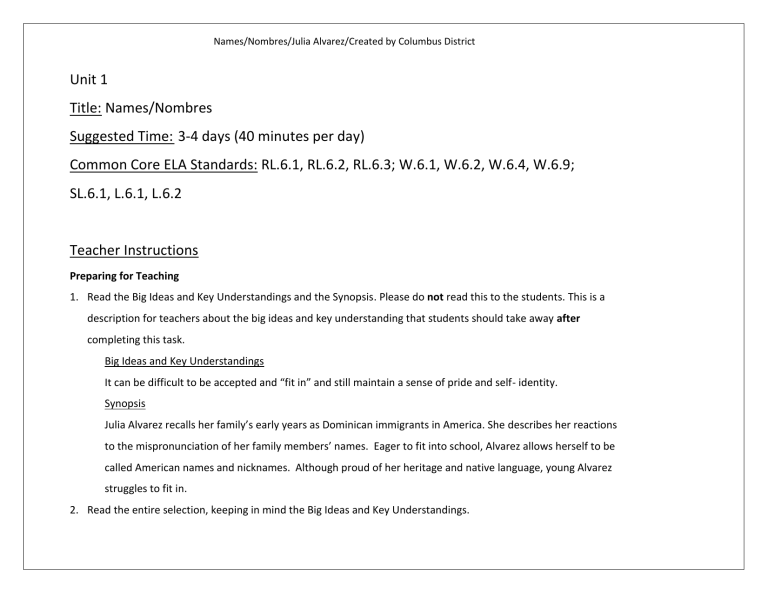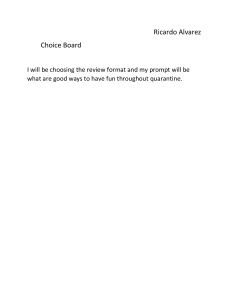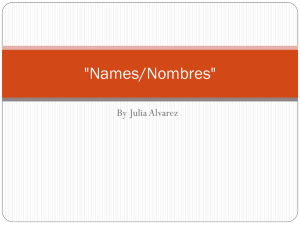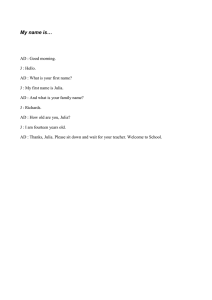
Names/Nombres/Julia Alvarez/Created by Columbus District Unit 1 Title: Names/Nombres Suggested Time: 3-4 days (40 minutes per day) Common Core ELA Standards: RL.6.1, RL.6.2, RL.6.3; W.6.1, W.6.2, W.6.4, W.6.9; SL.6.1, L.6.1, L.6.2 Teacher Instructions Preparing for Teaching 1. Read the Big Ideas and Key Understandings and the Synopsis. Please do not read this to the students. This is a description for teachers about the big ideas and key understanding that students should take away after completing this task. Big Ideas and Key Understandings It can be difficult to be accepted and “fit in” and still maintain a sense of pride and self- identity. Synopsis Julia Alvarez recalls her family’s early years as Dominican immigrants in America. She describes her reactions to the mispronunciation of her family members’ names. Eager to fit into school, Alvarez allows herself to be called American names and nicknames. Although proud of her heritage and native language, young Alvarez struggles to fit in. 2. Read the entire selection, keeping in mind the Big Ideas and Key Understandings. Names/Nombres/Julia Alvarez/Created by Columbus District 3. Re-read the text while noting the stopping points for the Text Dependent Questions and teaching Tier II/academic vocabulary. During Teaching 1. Students read the entire selection independently. 2. Teacher reads the text aloud while students follow along, reading in their head. Depending on the text length and student need, the teacher may choose to read the full text or a passage aloud. For a particularly complex text, the teacher may choose to reverse the order of steps 1 and 2. 3. Students and teacher re-read the text while stopping to respond to and discuss the questions, continually returning to the text. Use think-pair-share to discuss and develop the meanings of “Words that require more time to learn.” Text Dependent Questions Text-dependent Questions In paragraph 1 the family’s name is mispronounced by the Immigration officer. Describe the author’s reactions to the mispronunciation. Describe the author’s attitude toward her American “new names” on pages 114- 115. Evidence-based Answers Julia’s reaction was to pronounce the name correctly in her head, but not out loud because she was afraid her family would not be let into the country if she corrected the officer’s pronunciation. She wondered how anyone could get “Elbures” out of “All-vah-rr-es”. At first, the author worried about correcting the mispronunciations of her name and she said “it took me a while to get used to my new names”. However, by high school the author said she “was a popular kid” and that is showed in her name. In high school she had names like “Jules” “Hey, Jude” and “Alcatraz”. Names/Nombres/Julia Alvarez/Created by Columbus District Why did Julia’s mother quote Shakespeare, “a rose by any other name would smell as sweet”? (page 115) On page 115 Alvarez states “Ironically, although she had the most foreign sounding name, she and I were the Americans in the family". Explain what the author meant by this statement. How did Julia’s older sister get her name? Why did the older sister have the hardest time getting an American name? What happened with Mami and the other new mothers after the sister was born? (page 116) Julia wondered if she shouldn’t correct her teachers and new friends when they mispronounce her name. “My mother argued that it didn’t matter.” Her mother’s attitude was not to correct anyone because it didn’t matter; Julia’s name didn’t change who she was. What makes this statement ironic is that she and her sister were not immigrants. They were actually born in New York City, but had foreign sounding names. Julia’s father’s mother had died before her older sister was born, so her father wanted the sister to have his mother’s name. However, Mami thought it was an ugly name, so she talked her husband into “Mauricia”. Her mother was embarrassed of the “noisy name” of Mauricia and told the other new mothers the baby’s name was Maureen. When the other mothers asked why she had given the baby an Irish name instead a pretty Spanish name, the mother blushed and admitted the baby’s real name. The name “Mauricia” does not translate into English and Julia pitied her older sister for her name. On page 117, why did the author state that her The author stated that Ana “had the easiest time of all” younger sister, Ana, “had the easiest time of all”? How because her name was “plain Anne” and she “turned did the pronunciation of Ana’s name change over time? out to be the pale, blond “American beauty” in the family”. The pronunciation of her named changed from “Ana” to “Ah-nah” in the late sixties when people started to pronounce Third World names correctly. The term ethnicity means belonging to a social group Alvarez is stating that it was not popular to be ethnic that has a common national or cultural tradition. What during that time because she claims “those were the does Alvarez mean by her statement on page 117 blond, blue-eyed bobby-socked years of junior high and “ethnicity was not yet “in”? high school before the sixties ushered in peasant Names/Nombres/Julia Alvarez/Created by Columbus District Cite the evidence that demonstrates that Julia did not want to be treated as the “rare, exotic friend.” from pages 117-118. How does the description of Julia’s extended family on pages 118-119 further reveal her need to fit in? How does Alvarez’s attitude about her and her family being different change during the story? Site evidence from the story in your answer. blouses, hoop earrings, serapes.” She means that at that time it was not popular to be different and to not conform to the norm. Julia stated she just wanted to be known as Judy and merge with the Sallys and Janes. When she was asked where she was from she would reply New York. Julia wanted to fit in and not be treated differently. She stated that “I burned with shame whenever they singled me out as a foreigner”. Julia was self-conscious about her relatives’ behavior at the graduation which included: too many family members attending the graduation, sneaking in without tickets, sitting in the front row, and constantly talking. She was also embarrassed when introducing them to friends because they had complicated names and convoluted relationships. The author wrote “Introducing them to my friends was a further trial to me”. At the beginning of the essay, Alvarez is proud of her heritage and wants to correct pronunciation of her family members’ names at the immigration office. Eager to fit in at school, she allows herself to be called American names and nicknames. In junior high and high school, she struggles to fit in and be accepted. When asked where, she claims she’s from New York instead of claiming her family’s native country. Finally, Alvarez seems to accept her differences and takes pride in them as evidenced by the joy she describes and the advantages in sharing her graduation party with a large family, “many gifts- that was a plus to a large family!” Names/Nombres/Julia Alvarez/Created by Columbus District Meaning needs to be provided Meaning can be learned from context Tier II/Academic Vocabulary These words require less time to learn These words require more time to learn (They are concrete or describe an object/event/ process/characteristic that is familiar to students) (They are abstract, have multiple meanings, are a part of a word family, or are likely to appear again in future texts) Page 114 - Orchestra (of sound) Page 116 – transport Page 117- merge Page 117 - hesitated Page 117 - ushered Page 118 - curious Page 118 - exotic Page 120 - inscribed Page 114 – immigration Page 115- “foreign- sounding” Page 115 – Namesake Page 115 -Trace Page 116 - Delivery Page 116 - Borders Page 118 - Burned (with shame) Page 118 - Rattling (off) Page 118 - Extended (family) Page 118 - foreigner Page 118 - chaotic Page 119 - convoluted Page 119 - Trial (to me) Page 119 - rarely Page 114 - trilling Page 114 - pronunciation Page 115 - mistook Page 115 - pursue Page 116 - mispronunciation Page 116 - blushed Page 117 - affectionate Page 118 - surnames Page 118 - bazaar Page 119- commencement Page 120 - portable Page 114 - declare Page 115 - super Page 115 - ironically Page 117 - ethnicity Page 117 - inevitably Page 117 - originally Page 117 - vaguely Page 117 - specified Page 118 - heritage Names/Nombres/Julia Alvarez/Created by Columbus District Culminating Writing Task Prompt At the end of Names/Nombres, Alvarez states that “Someday, the family predicted, my name would be wellknown throughout the United States. I laughed to myself, wondering which one I would go by.” Does this statement represent the author’s acceptance of her self-identity? Support your claim by tracing the author’s journey of being accepted and fitting in while maintaining her self-identity. Compose an argument that is one page in length. Support your claims with valid reasoning and relevant and sufficient evidence from the text, including direct quotes and page numbers. Teacher Instructions 1. Students identify their writing task from the prompt provided. 2. Students complete an evidence chart as a pre-writing activity. Teachers should remind students to use any relevant notes they compiled while reading and answering the text-dependent questions. Evidence Quote or paraphrase “I was too afraid we wouldn’t be let in if I corrected the man’s pronunciation but I said our name to myself.” Page number 114 “By the time I was in high school I was a popular kid and it showed in my name.” 115 “My initial desire to be known by my correct Dominican name faded. I just wanted to be Judy and merge with the Sallys and Janes in my class. 117 Elaboration / explanation of how this evidence supports ideas or argument At the beginning of the essay, Alvarez was proud of her name and said it correctly in her head. She could not understand how others could not get the “orchestra of sounds” correct. Alvarez was transitioning her identity, moving away from her heritage and looking for acceptance in her high school friendships. Alvarez now sees herself as an American more than a Dominican and does not want to be seen as a foreigner or “exotic friend”. She tries to Names/Nombres/Julia Alvarez/Created by Columbus District But inevitably, my accent and coloring gave me away” When classmates ask her where she is from, she tells them New York, and when they ask where she is originally from she vaguely tells them the Caribbean. When continue to inquire and ask if she is from “Portoriko”, she reluctantly admits “No…From the Dominican Republic.” “My Dominican heritage was never more apparent than when my extended family attended school occasions.” Alvarez came to enjoy having a big family for many reasons. The story ends with “Someday, the family predicted, my name would be wellknown throughout the United States. I laughed to myself, wondering which one I would go by.” 117 118 120 blend in and is disappointed when her accent and coloring let others see her heritage. Julia’s reluctance to admit her heritage supports the argument that she transitions into a new identity. Alvarez was still embarrassed by her Dominican heritage that was portrayed by her family members when they came to school functions, for example, when little cousins snuck in or talked throughout the presentation. Alvarez is accepting both her Dominican heritage as well as American culture. 3. Once students have completed the evidence chart, they should look back at the writing prompt in order to remind themselves what kind of response they are writing (i.e. expository, analytical, argumentative) and think about the evidence they found. (Depending on the grade level, teachers may want to review students’ evidence charts in some way to ensure accuracy.) From here, students should develop a specific thesis statement. This could be done independently, with a partner, small group, or the entire class. Consider directing students to the following sites to learn more about thesis statements: Names/Nombres/Julia Alvarez/Created by Columbus District http://owl.english.purdue.edu/owl/resource/545/01/ OR http://www.indiana.edu/~wts/pamphlets/ thesis_statement.shtml. 4. Students compose a rough draft. With regard to grade level and student ability, teachers should decide how much scaffolding they will provide during this process (i.e. modeling, showing example pieces, sharing work as students go). 5. Students complete final draft. Sample Answer The author’s statement at the end of the story, “Someday, the family predicted, my name would be well-known throughout the United States. I laughed to myself, wondering which one I would go by,” represents the author’s acceptance of her self-identity. The essay traces the struggle Alvarez goes through as a child coming to age in the United States and as an immigrant trying to “fit-in”. As she grows into adulthood and assimilates into the culture, Julia begins to accept her new identity as an American, while still maintaining pride in her heritage. At the beginning of the essay, Alvarez was proud of her heritage and where she came from, which is evidenced by her reaction to the mispronunciation of her name. Julia could not understand how others could not get the “orchestra of sounds” correct and is dumbfounded when the Immigration officer pronounced her family’s last name incorrectly when the family first arrived in New York. She says “I was too afraid we wouldn’t be let in if I corrected the man’s pronunciation but I said our name to myself.” (page 114) As she starts school, Julia wonders if she should correct her teachers and new friends when they mispronounce her name. “My mother argued that it didn’t matter.” Her mother’s attitude Names/Nombres/Julia Alvarez/Created by Columbus District was not to correct anyone because it didn’t matter; Julia’s name didn’t change who she was. Julia begins to follow her mother’s advice and does not worry so much about maintaining her identity with the Dominican Republic and begins to let go of her strong ties to her heritage (page 115). By the time she is in high school, Alvarez begins transitioning and moves away from her original insistence on maintaining her heritage. She begins to look for acceptance through her friendships. Alvarez claims, “By the time I was in high school I was a popular kid and it showed in my name.”(page 115) She welcomes the “Americanization” of her Dominican name and begins to reject and deny her background. “My initial desire to be known by my correct Dominican name faded. I just wanted to be Judy and merge with the Sallys and Janes in my class. But inevitably, my accent and coloring gave me away.”(page 117) Alvarez now sees herself as an American more than a Dominican and does not want to be seen as a foreigner or “exotic friend”. She tries to blend in and is disappointed when her accent and coloring reveal her background. When classmates ask her where she is from, she tells them “New York, “. When they ask where she is originally from, Alvarez vaguely responds “the Caribbean”. They continue to inquire and ask if she is from “Portoriko”, she reluctantly admits “No…from the Dominican Republic.”(Page 117) Julia’s reluctance to admit her heritage supports the argument that she is transitioning into a new identity. Alvarez continues to hide her Dominican heritage in high school. When her family members attend school functions, Julia feels embarrassed by their behavior, for example, little cousins sneak in without tickets and talk throughout the program. At the end of the essay, Alvarez comes to terms with her selfidentity. Instead of being embarrassed or ashamed of her family background and Dominican heritage, she realizes the advantages of her diversity and begins to appreciate her family and rich culture. This is evidenced by her claim at the end of the essay, “Someday, the family predicted, my name would be well- Names/Nombres/Julia Alvarez/Created by Columbus District known throughout the United States. I laughed to myself, wondering which one I would go by.” The fact that she accepts the variations of her name symbolizes the acceptance of her self-identity and heritage. Additional Tasks In the selection, Alvarez explains the story of how her sister was named. Research your name. What does it mean? Is there a story about how you were named? Research your family tree to find out if there are any immigrants in your family. Find out where they came from, where they lived, when they first arrived in the country and what they did for a living. When Alvarez first immigrates to the United States, she is an outsider. Describe, in detail, a time when you were an outsider and trying to “fit in”. Note to Teacher Create a graphic organizer with the following words and translations prior to first read and keep posted throughout the lesson: Page [115] - sancocho-stew Page [117] – serapes-blanket worn by men Page [119] – madrina-god mother Page [119] – comadre-friend, gossip mangul Page [120] - mis hermanas-my sister Page [120] – tios-uncles Page [120] - tias-aunts Page [120] – primas-female cousin Page [120] – pudin-pudding Page [120] – vamonosos-let’s go Names/Nombres/Julia Alvarez/Created by Columbus District Supports for English Language Learners (ELLs) to use with Anthology Alignment Lessons When teaching any lesson, it is important to make sure you are including supports to help all students. We have prepared some examples of different types of supports that you can use in conjunction with our Anthology Alignment Lessons to ensure ELLs can engage fully with the lesson. While these supports reflect research in how to support ELLs, these activities can help ALL students engage more deeply with these lessons. Note that some strategies should be used at multiple points within a lesson; we’ll point these out. It is also important to understand that these scaffolds represent options for teachers to select based on students’ needs; it is not the intention that teachers should do all of these things at every lesson. Before reading: Read passages, watch videos, view photographs, discuss topics (e.g., using the four corners strategy), or research topics that help provide context for what your students will be reading. This is especially true if the setting (e.g., 18th Century England) or topic (e.g., boats) is one that is unfamiliar to the students. Provide explicit instruction, using multiple modalities, on selected vocabulary words that are central to understanding the text. When looking at the lesson plan, you should note the Tier 2 words, particularly those words with high conceptual complexity (i.e., they are difficult to visualize, learn from context clues, and are abstract), and consider introducing them ahead of reading. For more information on selecting such words, go here. You should plan to continue to reinforce these words, and additional vocabulary, in the context of reading and working with the text. (See additional activities in the During Reading and After Reading sections.) Examples of Activities: o Provide students with the definition of the words and then have students work together to create Frayer models or other kinds of word maps for the words. o When a word contains a prefix or suffix that has been introduced before, highlight how the word part can be used to help determine word meaning. o Keep a word wall or word bank where these new words can be added and that students can access later. o Have students create visual glossaries for whenever they encounter new words. Then have your students add these words to their visual glossaries. Names/Nombres/Julia Alvarez/Created by Columbus District o o o Create pictures using the word. These can even be added to your word wall! Create lists of synonyms and antonyms for the word. Have students practice using the words in conversation. For newcomers, consider providing them with sentence frames to ensure they can participate in the conversation. Use graphic organizers to help introduce content. Examples of Activities: o Complete a Know, Want to Learn, Learned (KWL) graphic organizer about the text. o Have students research the setting or topic and fill in a chart about it. You could even have students work in groups where each group is assigned part of the topic. o Fill in a bubble map where they write down anything that they find interesting about the topic while watching a video or reading a passage about the topic. Then students can discuss why they picked the information. During reading: Allow ELLs to collaborate in their home languages to process content before participating in whole class discussions in English. Consider giving them the discussion questions to look over in advance (perhaps during the first read) and having them work with a partner to prepare. Allow ELLs to use English language that is still under development. Students should not be scored lower because of incorrect spelling or grammar (unless the goal of the assignment is to assess spelling or grammar skills specifically). When grading, be sure to focus on scoring your students only for that objective. Scaffold questions for discussions so that questioning sequences include a mix of factual and inferential questions and a mix of shorter and more extended responses. Questions should build on each other and toward inferential and higher order thinking questions. There are not many factual questions already listed in the lesson instructions, so you will need to build some in as you see fit. More information on this strategy can be found here. Provide explicit instruction, using multiple modalities, on selected vocabulary words (e.g., 5–8 for a given text) that are central to understanding the text. During reading, you should continue to draw attention to and discuss the words that you taught before the reading. Names/Nombres/Julia Alvarez/Created by Columbus District Examples of Activities: o Have students include the example from the text in a student-created glossary. o Create pictures that represent how the word was used in the passage. o Create sentences using the word in the way it was used in the passage. o Have students discuss the author’s word choice. o Examine important sentences in the text that contribute to the overall meaning of the text. Examine sentence structure of a particular sentence. Break down the sentence to determine its meaning. Then determine how this sentence contributes to the overall meaning of the passage. Determine if there is any figurative language in the sentence and have students use context clues to determine the meaning of the figurative language. Use graphic organizers to help organize content and thinking. Examples of Activities: o While reading the text, have students fill in a story map to help summarize what has happened. o Have students fill in an evidence chart while they read to use with the culminating writing activity. Make sure to model with the students how to fill in the evidence chart by filling in the first couple of rows together as a class. Go over the prompt that the evidence should support, making sure to break down what the prompt means before having the students get to work. If some of your students frequently struggle to understand directions, have the students explain the directions back to you. o Provide somewhere for students to store new words that they encounter. Students could use a chart to keep track of these new words and their meanings as they read. o If you had students start a KWL before reading, have them fill in the “L” section as they read the passage. After reading: Reinforce new vocabulary using multiple modalities. Examples of activities: o Using the words that you had students work with before the reading, require students to include the words in the culminating writing task. o Create Frayer models with the words. Then cut up the Frayer models and have the students put the Frayer models back together by matching the pieces for each word. Names/Nombres/Julia Alvarez/Created by Columbus District After reading the passage, continue to examine important sentences (1–2) in the text that contribute to the overall meaning of the text. Guide students to break apart these sentences, analyze different elements, and determine meaning. More information on how to do this, including models of sentence deconstruction, can be found here. When completing the writing assignments after reading, consider using these scaffolds to support students depending on their English proficiency. Examples of Activities: o For all students, go over the prompt in detail making sure to break down what the prompt means before having the students get to work. Then have the students explain the directions back to you. o Have students create an evidence tracking chart during reading, then direct them to look back over their evidence chart and work with a group to see if their evidence matches what the rest of the class wrote down. If some of the chart does not match, students should have a discussion about why. o For students who need more support, model the proper writing format for your students and provide them with a properly formatted example for reference. o For newcomers, you may consider creating sentence or paragraph frames to help them to write out their ideas.





